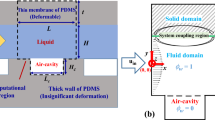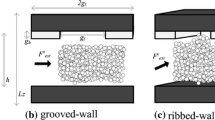Abstract
Superhydrophobic microchannels have evolved recently as an accepted strategy to mitigate the hydrodynamic resistance tendered in micro-constrictions. In this work, hydrodynamics of a hydrophobic microchannel realized by entrapping air in the cavities located between transversely oriented ribs is numerically investigated. An interface formed between the liquid and air/vapor in the confinement facilitates a resistance free slipping surface for the flowing water. The shape of the meniscus is determined by the pressure difference between air and liquid and is classified as convex, flat, and concave depending on the protrusion angle. Several applications require a long hydrophobic channel in which the liquid pressure decreases lengthwise; consequently the interface shape changes as well. In this regard, a mathematical model is proposed to predict the protrusion angle at a specific distance from the inlet of microchannel. This is incorporated in the computational fluid dynamics (CFD) simulations to define the static geometry of the interface which is varying throughout the length of the channel. Moreover, the boundary is treated as a combination of flat no-slip and curved shear-free regions to mimic the ribs and cavities. Further, the evolution of interface morphology is captured using the volume-of-fluid (VOF) scheme by considering a static contact angle at the solid surface to check the validity of the suggested model. Dynamically evolved protrusion angle is measured for various liquid–gas interface pressures and it is observed that the theoretical scaling proposed by Laplace and Young is well obeyed. Though CFD–VOF simulation scheme is an effective tool for predicting the pressure dependent liquid–gas meniscus and concurrent hydrodynamics of the ribbed microchannel, it is resource intensive. The present study demonstrates that the developed model for static boundary may be adopted alternatively to predict the hydrodynamics of a long hydrophobic microchannel by saving computational resources.
Similar content being viewed by others
Change history
05 February 2022
A Correction to this paper has been published: https://doi.org/10.1007/s42757-022-0132-z
References
Bazant, M. Z., Vinogradova, O. I. 2008. Tensorial hydrodynamic slip. J Fluid Mech, 613: 125–134.
Belyaev, A. V., Vinogradova, O. I. 2010. Effective slip in pressure-driven flow past super-hydrophobic stripes. J Fluid Mech, 652: 489–499.
Benzi, R., Biferale, L., Sbragaglia, M., Succi, S., Toschi, F. 2006. Mesoscopic modelling of heterogeneous boundary conditions for microchannel flows. J Fluid Mech, 548: 257–280.
Bobji, M. S., Kumar, S. V., Asthana, A., Govardhan, R. N. 2009. Underwater sustainability of the “cassie” state of wetting. Langmuir, 25: 12120–12126.
Brackbill, J. U., Kothe, D. B., Zemach, C. 1992. A continuum method for modeling surface tension. J Comput Phys, 100: 335–354.
Byun, D., Kim, J., Ko, H. S., Park, H. C. 2008. Direct measurement of slip flows in superhydrophobic microchannels with transverse grooves. Phys Fluids, 20: 113601.
Callies, M., Quéré, D. 2005. On water repellency. Soft Matter, 1: 55–61.
Cheng, Y. P., Teo, C. J., Khoo, B. C. 2009. Microchannel flows with superhydrophobic surfaces: Effects of Reynolds number and pattern width to channel height ratio. Phys Fluids, 21: 122004.
Choi, C. H., Kim, C. J. 2006. Large slip of aqueous liquid flow over a nanoengineered superhydrophobic surface. Phys Rev Lett, 96: 066001.
Choi, C. H., Ulmanella, U., Kim, J., Ho, C. M., Kim, C. J. 2006. Effective slip and friction reduction in nanograted superhydrophobic microchannels. Phys Fluids, 18: 087105.
Cottin-Bizonne, C., Barentin, C., Charlaix, Bocquet, L., Barrat, J. L. 2004. Dynamics of simple liquids at heterogeneous surfaces: Molecular-dynamics simulations and hydrodynamic description. Eur Phys J E, 15: 427–438.
Davies, J., Maynes, D., Webb, B. W., Woolford, B. 2006. Laminar flow in a microchannel with superhydrophobic walls exhibiting transverse ribs. Phys Fluids, 18: 087110.
Davis, A. M. J., Lauga, E. 2009. Geometric transition in friction for flow over a bubble mattress. Phys Fluids, 21: 011701.
Dilip, D., Bobji, M. S., Govardhan, R. N. 2015. Effect of absolute pressure on flow through a textured hydrophobic microchannel. Microfluid Nanofluid, 19: 1409–1427
Dilip, D., Jha, N. K., Govardhan, R. N., Bobji, M. S. 2014. Controlling air solubility to maintain “Cassie” state for sustained drag reduction. Colloids Surf A, 459: 217–224.
Gaddam, A., Garg, M., Agrawal, A., Joshi, S. S. 2015. Modeling of liquid-gas meniscus for textured surfaces: Effects of curvature and local slip length. J Micromech Microeng, 25: 125002.
Gao, P., Feng, J. J. 2009. Enhanced slip on a patterned substrate due to depinning of contact line. Phys Fluids, 21: 102102.
Govardhan, R. N., Srinivas, G. S., Asthana, A., Bobji, M. S. 2009. Time dependence of effective slip on textured hydrophobic surfaces. Phys Fluids, 21: 052001.
Granick, S., Zhu, Y., Lee, H. 2003. Slippery questions about complex fluids flowing past solids. Nat Mater, 2: 221–227.
Haase, A. S., Karatay, E., Tsai, P. A., Lammertink, R. G. H. 2013. Momentum and mass transport over a bubble mattress: The influence of interface geometry. Soft Matter, 9: 8949–8957.
Harting, J., Kunert, C., Hyväluoma, J. 2010. Lattice Boltzmann simulations in microfluidics: Probing the no-slip boundary condition in hydrophobic, rough, and surface nanobubble laden microchannels. Microfluid Nanofluid, 8: 1–10.
Hirt, C., Nichols, B. 1981. Volume of fluid (VOF) method for the dynamics of free boundaries. J Comput Phys, 39: 201–225.
Karatay, E., Haase, A. S., Visser, C. W., Sun, C., Lohse, D., Tsai, P. A., Lammertink, R. G. 2013a. Control of slippage with tunable bubble mattresses. Proc Nat Acad Sci, 110: 8422–8426.
Karatay, E., Tsai, P. A., Lammertink, R. G. H. 2013b. Rate of gas absorption on a slippery bubble mattress. Soft Matter, 9: 11098–11106.
Lauga, E., Brenner, M., Stone, H. 2007. Microfluidics: The no-slip boundary condition. In: Springer Handbook of Experimental Fluid Mechanics. Tropea, C., Yarin, A. L., Foss, J. F. Eds. Springer Berlin Heidelberga: 1219–1240.
Lauga, E., Stone, H. A. 2003. Effective slip in pressure-driven Stokes flow. J Fluid Mech, 489: 55–77.
Li, C., Zhang, S., Xue, Q., Ye, X. 2016. Simulation of drag reduction in superhydrophobic microchannels based on parabolic gas-liquid interfaces. Phys Fluids, 28: 102004.
Lobaton, E. J., Salamon, T. R. 2007. Computation of constant mean curvature surfaces: Application to the gas-liquid interface of a pressurized fluid on a superhydrophobic surface. J Colloid Inter Sci, 314: 184–198.
Maynes, D., Crockett, J. 2014. Apparent temperature jump and thermal transport in channels with streamwise rib and cavity featured superhydrophobic walls at constant heat flux. J Heat Transfer, 136: 011701.
Maynes, D., Jeffs, K., Woolford, B., Webb, B. W. 2007. Laminar flow in a microchannel with hydrophobic surface patterned microribs oriented parallel to the flow direction. Phys Fluids, 19: 093603.
Navier, C. L. M. H. 1823. Memoire sur les lois du mouvement des fluides. Mémoires de l’Académie Royale des Sciences de l’Institut de France, 6: 389–440.
Ng, C. O. 2011. How does wall slippage affect hydrodynamic dispersion?. Microfluid Nanofluid, 10: 47–57.
Ou, J., Perot, B., Rothstein, J. P. 2004. Laminar drag reduction in microchannels using ultrahydrophobic surfaces. Phys Fluids, 16: 4635–4643.
Philip, J. R. 1972a. Flows satisfying mixed no-slip and no-shear conditions. Zeitschrift Für angewandte Mathematik und Physik ZAMP, 23: 353–372.
Philip, J. R. 1972b. Integral properties of flows satisfying mixed no-slip and no-shear conditions. Zeitschrift fr angewandte Mathematik und Physik ZAMP, 23: 960–968.
Ranjith, S. K. 2015. Mesoscopic simulation of single DNA dynamics in rotational flows. Eur Phys J E, 38: 89.
Ranjith, S. K., Patnaik, B. S. V., Vedantam, S. 2014. Transport of DNA in hydrophobic microchannels: A dissipative particle dynamics simulation. Soft Matter, 10: 4184–4191.
Ranjith, S. K., Vedantam, S., Patnaik, B. S. V. 2015. Hydrodynamics of flow through microchannels with hydrophobic strips. Microfluid Nanofluid, 19: 547–556.
Rothstein, J. P. 2010. Slip on superhydrophobic surfaces. Ann Rev Fluid Mech, 42: 89–109.
Schmieschek, S., Belyaev, A. V., Harting, J., Vinogradova, O. I. 2012. Tensorial slip of superhydrophobic channels. Phys Rev E, 85: 016324.
Steinberger, A., Cottin-Bizonne, C., Kleimann, P., Charlaix, E. 2007. High friction on a bubble mattress. Nat Mater, 6: 665–668.
Teo, C. J., Khoo, B. C. 2009. Analysis of Stokes flow in microchannels with superhydrophobic surfaces containing a periodic array of micro-grooves. Microfluid Nanofluid, 7: 353–382.
Teo, C. J., Khoo, B. C. 2014. Effects of interface curvature on Poiseuille flow through microchannels and microtubes containing superhydrophobic surfaces with transverse grooves and ribs. Microfluid Nanofluid, 17: 891–905.
Wang, Y., Bhushan, B. 2010. Boundary slip and nanobubble study in micro/nanofluidics using atomic force microscopy. Soft Matter, 6: 29–66.
Wang, Y., Li, B., Zhou, Y., Lu, Z., Yan, D. 2013. Dissipative particle dynamics simulation study on the mechanisms of self-assembly of large multimolecular micelles from amphiphilic dendritic multiarm copolymers. Soft Matter, 9: 3293–3304.
Woolford, B., Maynes, D., Webb, B. W. 2009. Liquid flow through microchannels with grooved walls under wetting and superhydrophobic conditions. Microfluid Nanofluid, 7: 121–135.
Xue, Y., Lv, P., Lin, H., Duan, H. 2016. Underwater superhydrophobicity: stability, design and regulation, and applications. Appl Mech Rev, 68: 030803.
Xue, Y., Lv, P., Liu, Y., Shi, Y., Lin, H., Duan, H. 2015. Morphology of gas cavities on patterned hydrophobic surfaces under reduced pressure. Phys Fluids, 27: 092003.
Ybert, C., Barentin, C., Cottin-Bizonne, C., Joseph, P., Bocquet, L. 2007. Achieving large slip with superhydrophobic surfaces: Scaling laws for generic geometries. Phys Fluids, 19: 123601.
Acknowledgements
The authors sincerely acknowledge the funding under DSTFIST and AICTE-RPS schemes of Government of India.
Author information
Authors and Affiliations
Corresponding author
Rights and permissions
About this article
Cite this article
Joseph, M.P., Mathew, G., Krishnaraj, G.G. et al. Numerical simulation of liquid–gas interface formation in long superhydrophobic microchannels with transverse ribs and grooves. Exp. Comput. Multiph. Flow 2, 162–173 (2020). https://doi.org/10.1007/s42757-019-0043-9
Received:
Revised:
Accepted:
Published:
Issue Date:
DOI: https://doi.org/10.1007/s42757-019-0043-9




